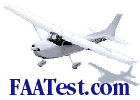| Terminal Control Areas
The FAA has adopted additional air traffic rules for the control or segregation of all aircraft within airspace designated as "terminal control areas" (TCA) surrounding some of the nation's busiest airports. The major problem inherent in a terminal airspace operation is the mixture of controlled and noncontrolled air traffic. The safest environment is, of course, one within which all aircraft are provided positive separation from each other. To increase safety and to reduce the risk of midair collisions,
a system has been developed to segregate air traffic operating to or from the
airports within the designated terminal control area (TCA) from other traffic
operating near that terminal area. All traffic operating within the terminal
control area is separated and controlled by ATC. This requires that aircraft
operating within this type designated airspace have certain communication and
navigation equipment. Appropriate authorization from ATC must be received prior
to operating within the terminal control area.
The terminal control areas are classed as Group I or Group II depending on the number of aircraft operations and passengers they service. To operate within either group, the aircraft must be equipped with an operable VOR or TACAN receiver, two way radio with capability for communicating with ATC and, with certain exceptions, an approved transponder. An encoding altimeter is required for Group I TCA. In addition, the pilot in command must have at least a Private Pilot Certificate to land or take off at an airport within a Group I Terminal Control Area. A transponder is not required for helicopters or for an airplane if flying IFR to other than the primary airport of either Group I or Group II areas, or VFR to Group II areas. The specific requirements are stipulated in Federal Aviation Regulations, Part 91.
|

